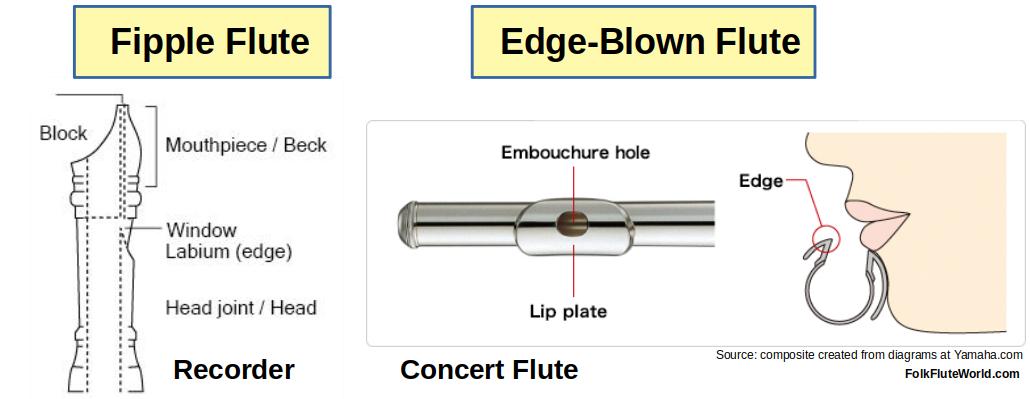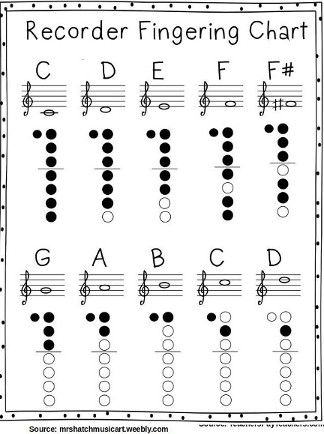by Howard Fosdick © FolkFluteWorld.com.

A Complete Set of Recorders (Courtesy of TurnerSCO.com)
Schools everywhere use plastic recorders to introduce children to music.
They're easy to play, durable, washable, and can be purchased for the price of a McDonald's dinner.
More importantly, recorders are professional musical instruments. Their range extends to two full octaves, they play all sharps and flats accurately, and they're tunable. Plus, they're versatile: they can play any musical style you prefer.
Recorders project a sweet, ethereal voice. Really? Depending on your early school experience with the instrument, you might find that hard to believe. Okay, then listen to how the instrument sounds in capable hands.
Convinced? This article tells you everything you need to know to get started with the recorder.
What's a Recorder?
There are hundreds of different kinds of flutes. Which are recorders?
First, musicians plays recorders vertically, rather than horizontally, like the metal concert flute.
Second, recorders feature a mouthpiece or fipple that directs the player's breath to a sharp edge. Splitting air on that edge, or labium, produces sound waves.
This diagram shows how a fipple works, versus the open blow hole of a concert flute:

The fipple is a very useful invention. It makes it much easier to get started playing. All you have to do is blow. In contrast, the concert flute only offers a lip plate. It's up to the player to properly direct his breath across the sharp edge. New flute players spend much time improving their embouchure before they master the entire scale.
One last defining characteristic: recorders have exactly seven holes on top and one underneath (for the lefthand thumb):

Two Recorders at Top, Two Tin Whistles Below
Among the seven holes, one or two may actually be "double-holes" -- two little holes spaced very closely together. (The large recorder above has two sets of double holes.) These are for playing sharps and flats. They count as a single hole for definitional purposes.
The recorder differs from the popular tin whistle or "whistle." As the above photo shows, whistles have only 6 holes on top and no thumb holes beneath. There are also many kinds of wood whistles that don't have the recorder's seven top holes.
History
The recorder dates back about as far as musical notation, some 700 years. It was quite a popular instrument in the 15th through the 18th centuries, in the Renaissance and Baroque periods. Composers like Vivaldi and Bach wrote for the recorder.
By the late 18th century, its popularity had plummeted. What ultimately sent it into obscurity was the desire for louder instruments that could be heard by audiences prior to electronic amplification. Metal instruments fulfilled this need. Mechanized concert flutes virtually exiled soft-voiced, keyless wood flutes like the recorder.
The 20th century saw a rival in the recorder's fortunes. The Dolmetsches in the United Kingdom, a father and son team, started making and teaching recorders. Peter Harlan of Germany recognized the recorder's cultural importance and invented a new fingering system. And Yoshitaka Sakamoto introduced the instrument to the far east in the 1930s. In the 1940s, plastic recorders were first produced.
Today the recorder occupies a central position in music education. But it also enjoys a significant role in everything from Renaissance music recitals to modern ensembles. With its low price, high capabilities, and versatility, it's the ideal instrument to learn and enjoy.
Sizes and Pitch
The photo at the top of this article shows that recorders come in several sizes. Most commonly you'll see the sopranino, soprano, alto, tenor, and bass. The larger the instrument, the lower its voice (and the more costly it is to purchase).
The ubiquitous soprano (or descant) recorder is tuned to the key of C. Its lowest note -- or base note -- is C5. That's one octave above "middle C" on the piano. The tenor is pitched one octave lower than the soprano.
The sopranino's base note is three notes higher than the soprano, putting it in the key of F. The alto (or treble) sounds one octave lower than that, and the bass is pitched yet another octave lower.
Materials
Recorders typically come in two materials: plastic and wood.
High-quality instrumental plastic offers superior price/performance because molds produce instruments with perfect accuracy every time. In contrast, all wood recorders require a bit of human finishing. The result is that an inexpensive plastic recorder is nearly always better than an inexpensive wood one.
Wood recorders preserve the instrument's tradition. Many feel wood presents a slightly softer, warmer tone than plastic. Yet good wood recorders are costly, and plastic offers reliabilty and durability for lower cost. Hence, you'll see that most players buy plastic instruments, while serious musicians opt for expensive wood instruments.
The most popular woods for inexpensive wood recorders are soft woods like pearwood and maple. Costly recorders come in exotic hardwoods like ebony, grenadilla, or rosewood. Characteristics like design, style, and voicing are probably more important than the type of wood. (Most important of all is musician's skill.)
Range and Fingering
Recorders can play two full octaves, plus all sharps and flats between. This partial fingering chart shows that it's pretty easy to finger the scale:

Playing the Scale is Easy (Courtesy of MrsHatchMusicArt.Weebly.com)
This chart shows the predominant fingering system, called Baroque (or English). The alternative fingering system is German. Baroque and German fingerings differ only for the fingering of F (and three sharps). In the U.S., baroque overwhelmingly predominates.
Most recorders consist of two pieces: a mouthpiece and a body. You tune by moving the mouthpiece in or out. You also clean the instrument by taking it apart. A few very cheap plastic recorders are one-piece, and some traditional wood models comprise three parts.
Buying Your First Recorder
Given all this, what should you buy for your first recorder?
First off, choose plastic. It's inexpensive, durable, and sounds great.
Secondly, start with the ubiquitous soprano. Lessons all address the soprano. Plus it's in the key of C, so tons of free sheet music are available online.
Which brand? Any decent recorder could work for you. But I suggest either a Yamaha or Aulos plastic soprano. These instruments are highly popular, maintain consistent quality, and have cool clear voices. A 300 series Yamaha or a Symphony or Robin series Aulos would be a great choice. These clock in at about $20-$35 USD retail. Stay away from the cheap $10 recorders made for schoolchildren.
If you develop proficiency with your recorder and become serious about the instrument, you might later opt for a wood instrument, or perhaps the lower-pitched alto. But start with a mainstream plastic soprano.
Learning to Play
There are tons of free resources on the internet to help you learn to play your new instrument. There's absolutely no need for a teacher or in-person lessons unless you prefer that learning style.
Here are a few of the free resources you can access on this website:
Click here for our list of free self-taught online courses and other community resources.
Click here to find lots of free instructional material over at Youtube.
Click here to access a ton of freely downloadable sheet music.
The Bottom Line
That schools use recorders with young children sometimes gives the instrument a bad reputation. It's undeserved. A well-played recorder sounds like a dream, and it has the same professional capabilites as many other serious musical instruments.
The recorder can play any style of music, and all the resources you need to learn are available for free on the internet.
Best of all, this is an easy instrument to start with.
I hope this article has helped you get started with this amazing instrument.